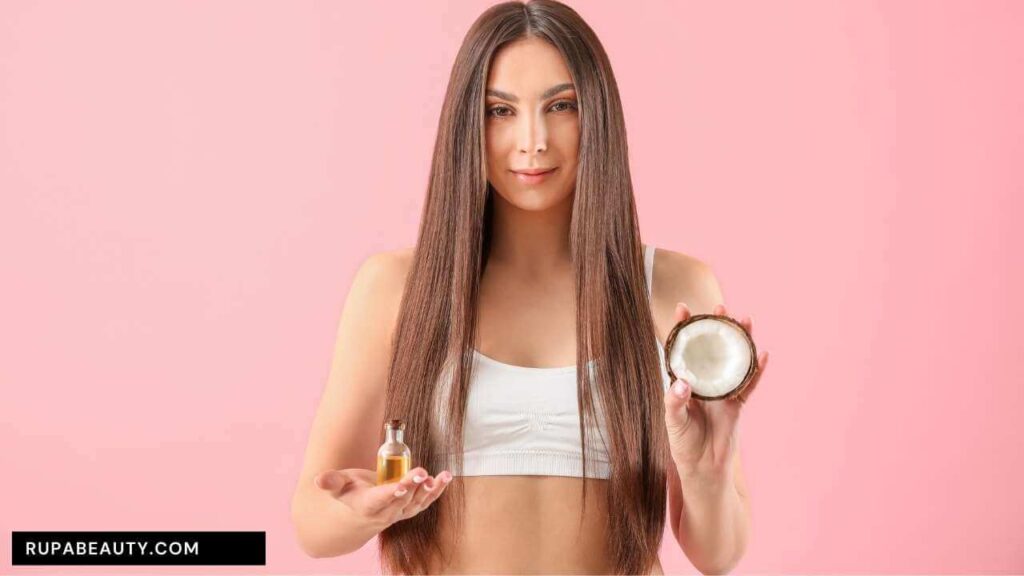Treatments for hair loss can be costly and invasive, and many people are dissatisfied with the outcomes. Natural is always ideal, and according to specialists, research on Coconut Oil for Male and Female Pattern Baldness is promising. Coconut oil is known to reduce testosterone-induced DHT production, preventing hair loss and promoting hair growth.
Table of Contents
Male Pattern Baldness
Dihydrotestosterone (DHT), a male steroid hormone that attaches to receptors in your scalp in genetically sensitive males and causes hair loss, is the primary cause of hair loss in men.
DHT may appear complex, but once you grasp how your body makes DHT and the effect DHT hormone has on hair follicles, you’ll be able to appreciate its role in hair loss.
We’ll go over what DHT is, how your body produces it, and how natural coconut oil can help you minimize DHT and prevent its bad effects on your hairline.

Female Pattern Baldness
Hair loss in women is known as female pattern baldness, also known as androgenetic alopecia. It’s comparable to male pattern baldness, except that women’s hair loss patterns differ from men’s. The hair growth phase slows significantly in female pattern baldness. It also takes a long time for new hair to grow. As hair follicles decrease, the hair that does grow becomes thinner and finer. This can lead to hair that is prone to breakage.
Women lose 50 to 100 hairs every day on average, but women with female pattern baldness can lose much more.
Hair loss in men begins in the front of the head and progresses to the back until they are completely bald. Women’s hair begins to fall out at their part line and spreads throughout their heads. Hair loss at the temples is also possible.
Women are less likely to go entirely bald, although you may have significant hair thinning.
What Is DHT?
DHT is a male sex hormone produced when particular enzymes in the testes and prostate of men and the ovaries of women convert testosterone. Except on the head, DHT is a stronger hormone than testosterone that is required for most hair growth. It may stay on to hair follicles for a long period there.
DHT causes receptors to start miniaturizing follicles, according to the American Hair Loss Association. Those receptors’ sensitivity is a hereditary trait. Your DHT levels may be within typical ranges for your age and gender, but it all relies on the receptors.
Miniaturization of the hair follicles causes male pattern baldness, resulting in a shorter growth phase and finally the disappearance of softer, lighter hairs. Androgenetic alopecia, telogen effluvium, anagen effluvium, and traction alopecia are all disorders caused by DHT production in women.
How DHT causes balding
Follicles, which are essentially small capsules that each contain a single strand of hair, generate hair all over your body from structures beneath your skin known as follicles.
A follicle’s hair passes through a growth cycle that lasts two to six years on average. Even if you shave or trim your hair, the root of the hair housed within the follicle will grow again out of the follicle.
The hair enters a resting phase at the end of this cycle before finally falling out a few months later. The follicle then creates new hair, and the cycle begins all over again.
High amounts of androgens, such as DHT, can reduce your hair follicles and shorten this cycle, causing hair to grow out thinner and brittle and fall out more quickly. When old hairs fall out, DHT might make it take longer for your follicles to develop new hairs.
Variations in the androgen receptor (AR) gene make certain persons more susceptible to DHT’s effects on scalp hair. Androgen receptors are proteins that bind to hormones such as testosterone and DHT. This binding activity is often associated with regular hormonal processes such as hair development on the body.
Variations in the AR gene, on the other hand, can enhance androgen sensitivity in your scalp follicles, increasing your risk of male pattern hair loss.
Coconut Oil for Male and Female Pattern Baldness

Coconut oil has been increasingly popular as a health supplement, in skincare products, and even in shampoos, conditioners, and other hair treatments in recent years.
Coconut oil’s popularity as an ingredient in shampoos and other hair products isn’t simply due to clever marketing; there’s plenty of scientific proof that it can be beneficial to your hair’s health when used correctly.
Coconut oil has a high amount of fat from medium-chain triglycerides (MCTs), predominantly in the form of lauric acid, which has been demonstrated in test tubes and animal experiments to inhibit DHT formation when taken orally. (Source)
While preclinical studies aid researchers in determining whether a medication is beneficial or safe, its findings cannot be applied to humans.
In test-tube and animal research, lauric acid, the most abundant MCT in coconut oil, has been found to inhibit DHT synthesis, although human trials are needed.
Treatments for hair loss can be costly and invasive, and many people are dissatisfied with the outcomes. Natural is always ideal, findings of Coconut Oil for Male and Female Pattern Baldness are promising and worth a try.
Do you know that if not done properly, oiling your hair with coconut oil can actually do more harm than good? Check this detailed article on How to Apply Coconut Oil to Hair in 6 Steps
Check the article on How Long do I Leave Coconut Oil In My Hair?
Disclaimer: This content contains advice, and is solely intended to provide general information. It is not a substitute for professional medical advice. For more information, always visit a professional or your personal doctor. RupaBeauty.com does not claim responsibility for this information.

Creative, versatile, and passionate about her craft, Rupa Das is a well-recognized name in the world of fashion and makeup! This is a woman who has been in the fashion and makeup industry for 24 years and is still one of the leading international makeup artist in the circuit! She has worked in big brands like Lakme, Green Trends, Colors and transitioned to become a Beauty (Hair & Skin) Trainer.
